IDR Blog
Battle of Bayra 1971 War
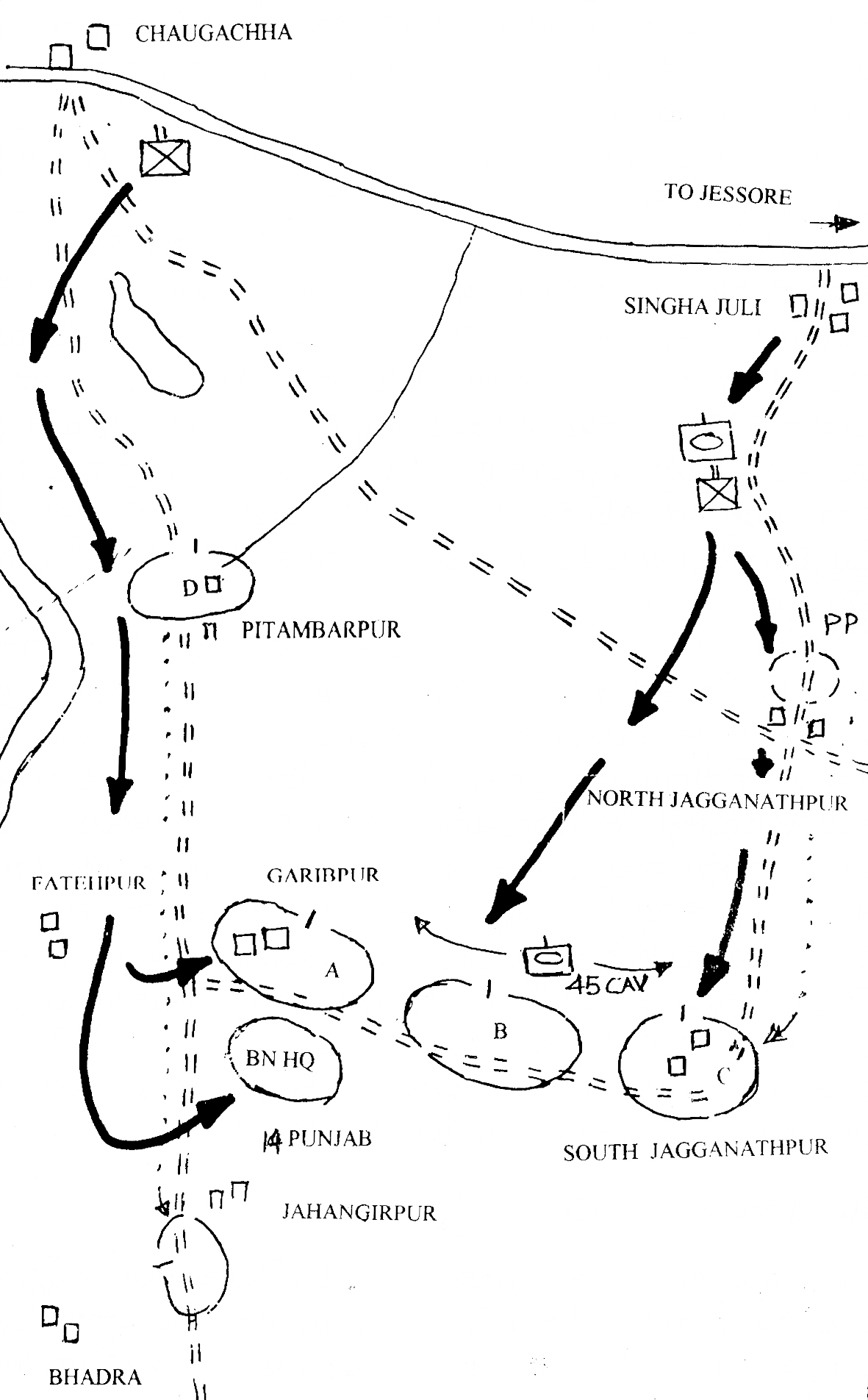
Battle of Bayra 1971
Background to the Battle
The Pakistan National Assembly election of December 17, 1970, resulted in Sheikh Mujibur Rehman and his Awami League of East Pakistan gaining an overwhelming victory. However West Pakistan was not prepared to be ruled by a party or Prime Minister from East Pakistan. The Assembly session was postponed and the Pakistan Army prepared for a military crackdown in Bangladesh. On March 25, 1971, Sheikh Mujibur Rehman was arrested and martial law was declared in East Pakistan. There followed an inhuman crackdown by the Pakistan Army. Intellectuals were selectively rounded up and eliminated. As resistance grew, thousands were murdered and the women raped. The Awami Party leadership and over one million refugees fled to India. The Awami League set up a Government in Exile and declared East Pakistan independent of Pakistan and gave it the name of Bangladesh. India approached the international community for justice. Nothing much happened. By April 1971, the Government of India was ready to go to’ war in aid of Bangladesh. But General Manekshaw, the Chief of Army Staff, persuaded the Government to postpone the offensive till the winter. A diplomatic offensive was launched. Mrs Gandhi undertook two tours abroad to personally brief the heads of important countries. She went to the Soviet Union in September 1971 and signed a treaty of friendship and co-operation with that country to neutralise the Chinese threat.
Mrs Gandhi gave General Manekshaw a free hand with regard to the preparations for the battle. Required funds were released. Soviet tanks and other essential equipment were procured despite resistance from the bureaucracy. A Mukti Babini of about three brigade strength was raised from the personnel of East Bengal Regiment. Another guerrilla force of about 70,000 to 80,000 was formed from military and para military personnel amongst the refugees and used to engage the Pakistani Army in irregular warfare. These attacks were quite successful. The prolonged counter insurgency resulted in heavy casualties to the Pakistani Army. They lost, 237 officers, 136 junior commissioned officers and 3,559 other ranks.
In May 1971, the Indian Army began to prepare for a military campaign, the outcome of which was to astound the world. General Manekshaw wanted a short decisive war. Considerable reorganisation and re-equipping of the army, particularly the Armoured Corps, Engineers and Artillery was carried out. The programme of annual turnover of units was held in abeyance. Reservists were called up for training before the monsoon. Leave and courses were curtailed. Units employed in counter insurgency operations in Nagaland and Mizoram and in aid to civil authorities in West Bengal were pulled out and allowed to tram for the anticipated operations. Tracks were improved. Bridges in border areas were strengthened. New logistic bases having hospitals, ordnance depots, ammunition dumps and supply depots were created and stocked. Requirements of bridging equipment and track construction material were calculated and dumped at suitable areas. Troops moved to their concentration areas and prepared for the oncoming battle.
The terrain in East Pakistan was not ideal for a swift campaign. Three great rivers, the Ganga (locally called Padma), the Brahmaputra (or Jamuna) and the Meghna and their tributaries and distributaries meandered across the vast plains. There were many lakes and swamps. Surface communications were very poor and cross-country movement was difficult due to paddy fields and lush vegetation.
Mukti Bahini operations slowly grew in intensity all along the borders and gradually drew the Pakistani Army forward. Part of this forward policy was an incorrect assessment of the Indian objectives. It was believed that India would be satisfied with capture of enough territory to enable a Bangladesh Government to be established and to rehabilitate the refugees. The feasibility of Indian troops capturing Dacca was never seriously considered. Hence, a forward policy was adopted to prevent loss of territory. It is estimated that Pakistan had lost about 8000 sq kms of territory to, Mukti Bahini in its border areas by October 1971. Pakistani troops often fired into Indian territory during clashes with Mukti Babini in border areas. Sometimes they made forays into Indian territory causing losses to Indian lives and property. This necessitated the positioning of the Indian troops close to the border. Shelling and counter shelling by both sides soon became common. Border clashes often took place. By November 1971, Pakistan had deployed her forces on the western front. It was obvious to all that war was round the corner.
Indian 2 Corps was given the task of capturing the Jessore Sector. The enemy had two regular and one adhoc brigade in the area. 107 Infantry Brigade was deployed for the defence of Jessore and 57 Infantry Brigade was deployed for the defence of Meherpur – Jenida Axis. 9 Infantry Division under General Dalbir Singh was given the task of capturing Jessore. Mter capturing Jessore, the Division was to send one brigade for capture of Khulna. The rest of the Division was to be prepared to assist 4 Mountain Division.
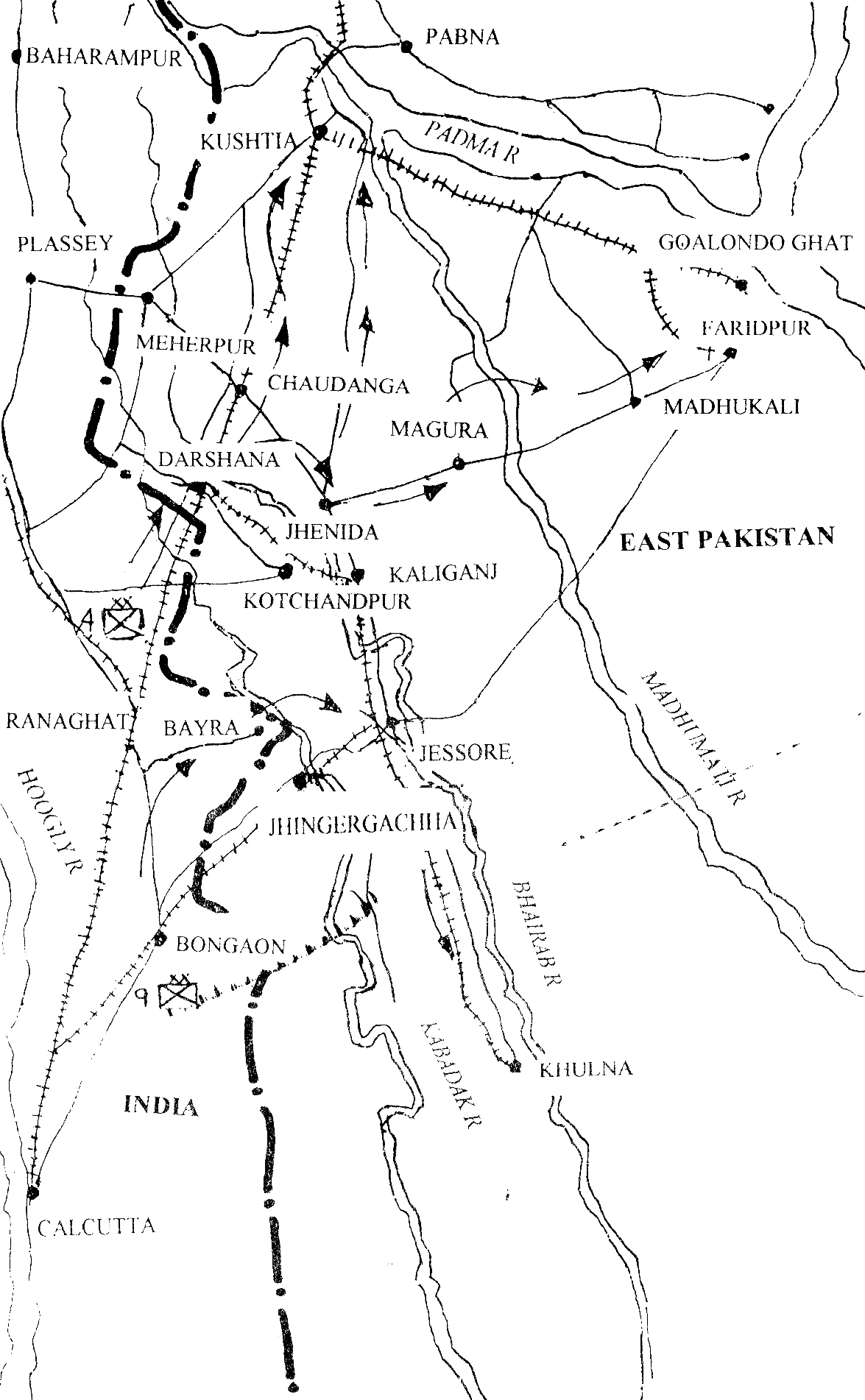
2 Corps Operation, 1971
Battle of Bayra, also called Battle of Garibpur, was not a set piece battle. I am sure that many would be surprised by its inclusion in the book. It was a preliminary operation. 9 Infantry Division was concentrated at Bongaon (Map) with one infantry brigade in the Bayra Salient. Expecting the main Bongaon – Jessore road to be heavily defended, particularly the crossings on Kabadak River near Jheingergacha, GOC 9 Infantry Division decided to secure a bridgehead across the Kabadak River near the international border at Bayra through a preliminary operation (Map).
Relative Strength
Garibpur village across the Kabadak River from Bayra was not strongly held. It was a part of the sector of Pakistan’s 107 Infantry Brigade, which was responsible for the defence of Jhenida. There were two approaches to Jessore from the Bayra Salient. The main one was from Bayra into East Pakistan through Chaugacha and then along Chaugacha – Abdulpur – Jessore. A subsidiary approach was through Mohammadpur. Chaugacha was held by a battalion. 107 Brigade also had a squadron of Chaffee tanks.
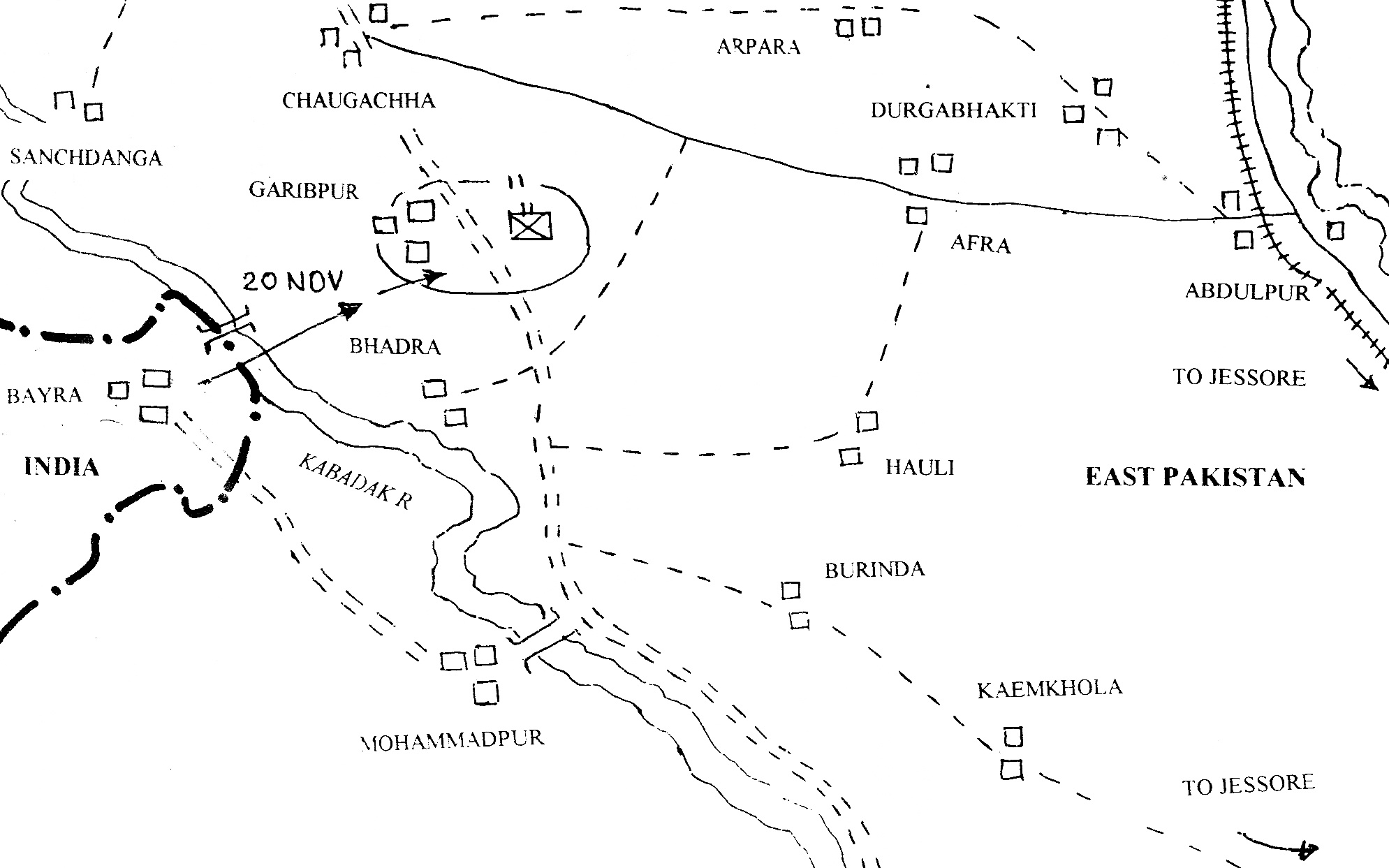
Area of Operation
42 Infantry Brigade of 9 Infantry Division was located in the Bayra area. A squadron of 45 Cavalry (PT 76 tanks), about two field companies from 102 Engineer Regiment and adequate artillery support were made available for the operations. 42 Infantry Brigade detailed 14 PUNJAB for the task. The Battalion was allotted a squadron of 45 Cavalry and a platoon of engineers for close support. As the operation would out flank the enemy defences at Chaugachha, the brigade commander expected a strong reaction from the enemy to the lodgement and warned the battalion commander accordingly.
The Battle
On November 20, 1971, 14 PUNJAB sent a strong patrol across the river in assault boats in the early hours of the morning. The patrol was led by Major AP Vishwanathan, one of the senior company commanders and had elements of all the elements of the battalion. The task of the patrol was to identify a suitable battalion-defended area east of Fatehpur village, which was about 4 kms from the border. The patrol clashed with an enemy patrol, which had moved south from Garibpur. The enemy patrol withdrew after a firefight. The patrol completed its mission. The Commanding Officer, 14 PUNJAB appreciated that surprise must have been lost and the enemy would reinforce the position. He decided to cross the Kabadak River with his battalion at the earliest. Orders were immediately passed. Two companies of the battalion along with the Battalion Commander’s Reconnaissance Party crossed the river mounted on the PT 76 tanks of the armoured squadron and secured Garibpur by 1645 hours on November 20. The Battalion Commander, Lt Col RK Singh quickly issued instructions on radio for the occupation of defences before the early winter night set in. D Company with a troop of tanks under Capt Balbir Singh took up positions in south Jaggannathpur. C Company with the rest of the squadron under Maj NS Bains moved further north and occupied general area Pitambarpur. The other two companies under Majors Vishwanathan and Machaiah were inducted by boats and occupied Garibpur area. Feverish activity was started to prepare the defences and to be ready for the enemy counter attack.
The engineers now came into play. 97 Field Company ex 102 Engineer Regiment assisted by one platoon of 268 Engineer Regiment constructed the first operational Krupman Bridge across Kabadak River during the night in a short period of three hours. 268 Engineer Regiment also constructed and operated a Class 9 ferry. Battalion support weapons and vehicles of the infantry battalion and armour were inducted into the lodgement by 0300 hours on November 21. Pakistani Sabres attacked the bridge on the morning of November 21. The damage was light. As a precautionary measure the bridge was partially dismantled, tied along the riverbank and camouflaged. Air reconnaissance by Pakistani aircraft failed to detect the bridge and reported that the bridge was destroyed. The bridge used to be reassembled every night for replenishment of the battalion and induction of a troop of T55 tanks of 63 Cavalry and elements of 42 Infantry Brigade into the bridgehead on the night of November 21/22. This led to a complete surprise to the enemy and the loss of its entire squadron of tanks in the battle on November 22. An engineer platoon ex 102 Engineer Regiment provided close engineer support to 14 PUNJAB during the operation. It laid mines, improved tracks and also occupied a platoon-defended locality near 14 PUNJAB battalion headquarters. (Refer Map No 19)
A patrol with Capt GS Gill and artillery observer Capt Chaturvedi had been moved to the area of Singha Juli, where Pakistani guns were located during the night of November 20/21. This was done to gain early warning and to hit the Pakistani guns accurately by an observed artillery shoot. In the cold foggy wintry morning of November 21, Capt Gill clearly heard the unmistakable sound of enemy tanks moving south from Chaugachha – Jessore Road. Fog and poor visibility allowed the patrol to remain close to the enemy column and report their positions accurately. Capt Chaturvedi was able to bring down some accurate shots on the massed Pakistani columns and cause casualties. In poor visibility, the patrol was nearly surrounded but managed to break away. Capt Chaturvedi was wounded and carried back by Capt Gill and other members of the patrol till they reached their company defences. C Company at Pitambarpur also reported enemy activity opposite as dawn broke out.
It now became apparent that an enemy tank column was, headed towards D Company at south Jaggannathpur and an enemy infantry column was headed towards Pitambarpur. The Company had moved forward at night but at dawn the Battalion Commander realised that it was too far forward. The Company was immediately ordered to fall back south to Jahangirpur. This readjustment was carried out with great skill almost in the face of the enemy.
With the direction of Pakistani thrust lines having been ascertained from the patrols, the tanks and recoilless guns were relocated to meet the threat. The first attack by Pakistan’s 6 Punjab was on Pitambarpur. But C Company had already withdrawn. The enemy’s attempts to out flank the Indian positions from the south were foiled by the Company. The main attack came frontally on A, B and D Companies. The infantry – tank assault came on D Company at 0600 hours on November 21. The enemy attacked confidently and one tank charged to within 25-m of the defences. The enemy’s tank and artillery fire had forced the recoilless gun crew back. But Havilder Lekh Raj, the crew leader, stayed back and knocked out the lead tank. One of the PT 76 tanks also hit an enemy tank, which happened to be the troop leader’s tank. Capt Gill shot the troop leader as he tried to get out of the tank. Other enemy tanks moved in and a melee developed. The squadron commander, 45 Cavalry, Major DS Narang, while directing the fight standing in his tank cupola, was hit and killed. Lt Tajinder Singh, a troop leader of the nearby troop was also hit and seriously wounded. However, the Indian troops held firm. By 0830 hours, after two and half hours of bitter fighting, the enemy attack petered out. The battlefield was strewn with dead bodies and burning tanks. As the fog rose, it revealed eleven enemy tanks, eight destroyed and three abandoned in working condition.
While this action was going on in the D Company locality, the enemy’s 6 Punjab, which had taken Pitambarpur, was closing in on Garibpur through woods to the west. The enemy battalion attacked the Battalion Headquarters and A Company from the west under heavy artillery and tank fire. The engineer platoon of 102 Engineer Regiment led by Lt RR Murthy had occupied a defended locality with the Battalion Headquarters. The platoon under Lt Murthy fought bravely and assisted in beating back the attack. For his gallantry and leadership in this action, Lt Murthy was awarded the Sena Medal. Very close artillery support directed by Maj Kailash Nath, the battery commander helped to break up the assault. Four enemy aircraft came in at 0900 hours, after the visibility had improved and strafed the Indian positions. One PT 76 tank was destroyed’ in the air attack. Pakistani troops launched another counter attack from the same direction at 1000 hours. This attack was also beaten back. 14 PUNJAB along with its supporting troops had been able to hold firm against determined enemy attacks.
In the afternoon at about 1430 hours three Pakistani Sabre jets came in for another attack. Gnats of the Indian Air Force intercepted the aircraft. In the dogfight that followed all the three enemy aircraft were shot down in full view of the troops in their trenches. This gave a great fillip to the morale of Indian troops.
A troop of T 55 tanks was inducted into the battlefield on the night of November 21/22. They shot up the three remaining Chaffee tanks on the morning of November 22. Pakistani troops had lost their entire armoured strength in the sector even before the war had actually begun. The Pakistani troops could only retire to lick their wounds and readjust their positions.
The Pakistani reaction to the Indian lodgement at Garibpur was unexpectedly violent. In the counter attacks they used 6 Punjab and elements of 21 Punjab and 22 Frontier Force and all the armour available to them. Pakistanis lost 15 Chaffee tanks, over 300 dead and wounded and 3 Sabre Jets, which were shot down by Indian Gnats. Indian Armour losses were 6 PT 76 tanks and 28 dead and wounded. The battle was also a saga of gallantry. The Commanding Officer 14 PUNJAB, Lt Col RK Singh was awarded the Maha Vir Chakra for his gallant conduct of the battle. Subedar Malkiat Singh of the Battalion and Major DS Narang of 45 Cavalry were posthumously awarded the Maha Vir Chakra. Vir Chakras were awarded to Capt GS Gill, Havildar Lekh Raj of 14 PUNJAB and Capt Chaturvedi of the Regiment of Artillery. Sena Medals were awarded to Capt Balbir Singh, the medical officer, and posthumously to L/Nk Sewa Singh of 14 PUNJAB, Major Kailash Nath, Regiment of Artillery and Lt Murthy of the Corps of Engineers. There were many “mention in Despatches”. The troops taking part in the Battle were also awarded the Battle Honour “GARIBPUR”.
The successful battle of Bayra completely upset the battle plans of 107 Infantry Brigade of the Pakistan Army and paved the way for successful capture of Jessore by 9 Infantry Division almost unopposed.
Analysis
Let us try to analyse the reasons for success at the Battle of Bayra / Garibpur. The first was the boldness and risk-taking ability of Lt Col RK Singh, Commanding Officer 14 PUNJAB. The loss of surprise due to the patrol clash did not deter him. He used speed of operations to maintain surprise and crossed the Kabadak River with two companies by day. His decision to withdraw C Company in the face of the enemy was a bold decision and a risky manoeuvre, which was successfully carried out.
The second was the ability of the Engineers to bridge the Kabadak River within three hours. This enabled the battalion support weapons, vehicles and adequate ammunition to be inducted into the bridgehead before first light and before enemy counter attacks. The innovation of dismantling the bridge by day and reassembling it by night not only helped to mislead the enemy into believing that the bridge had been destroyed and thus achieve surprise but also ensured that the bridge was not destroyed by enemy air attacks.
The third was the excellent patrolling work done by Capt Gill. Patrolling is the most difficult and hazardous of wartime activities. Shadow patrolling is the most difficult of all patrolling. Capt Gill and his men did this extremely well and ensured that complete and accurate information of enemy armour movement was continuously reported to his battalion commander. This enabled the timely redeployment of anti tank resources of the force and ensured that the counter attacks were repelled. The patrolled by Maj Vishwanathan also performed creditably. Not only did it have the upper hand in the patrol clash in enemy territory; it completed its mission successfully.
The fourth was all arms co-operation. This aspect is often not given the importance it deserves. The gallant spirit of 14 PUNJAB might not have brought success without effective armour, artillery and engineer support. Even the Air Force played a vital role by destroying the enemy aircraft. Effective all arms integration at all levels is key to success in all battles. This has been more than clearly demonstrated by the German Panzer Divisions in the Second World War.
The fifth was training. The battle once again demonstrated the importance of good training. The field craft and minor tactics displayed by 14 PUNJAB were excellent and could not have been possible without dedicated training. The performance of the squadron of 45 Cavalry was also excellent. The PT 76 tanks with the regiment were inferior to the Chaffee tanks with the enemy both in firepower and armour protection. The fact that in spite of this handicap, the squadron destroyed 10 Pakistani tanks for the loss of two of its own could only be due to better training. The move of infantry on tanks while crossing the Kabadak River displayed excellent infantry tank co-operation, which also comes through joint training. 102 Engineer Regiment was able to construct a Krupman Bridge across the river in just three hours. This was also possible due to good training. That the Second World War vintage Gnats could destroy the more advanced Sabre jets in aerial combat was also possible due to better training.
The sixth was regimental spirit. Regimental spirit motivates the individuals of the unit to brave all odds and give their best in battle. This spirit was clearly manifest in 14 PUNJAB. The commanding officer had considerably delayed his promotion to command the unit. Most of the officers were hard core. It was a happy and motivated unit and that it gave its best is clear from the number of awards it received for gallantry in battle.
Post your Comment
One thought on “Battle of Bayra 1971 War”
 Loading Comments
Loading Comments



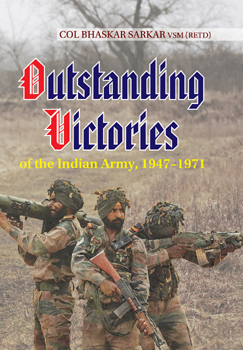
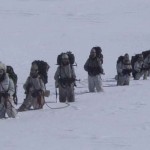
Excellent narration of an awe-inspiring tactical action.